On-orbit satellite servicing refers to refueling or repairing space satellites while in orbit. [1]
New commercial interest in on-orbit servicing of satellites is in large part due to the decreased costs of launching commercial satellites and the rise of low orbit, rather than geostationary, satellites for which servicing costs less. [2]
Although servicing of satellites has been theoretically considered since the early days of spaceflight, little was done.
The term is usually thought of as meaning autonomous or telerobotic servicing of a satellite by robotic spacecraft, but can also mean servicing that occurs by human astronauts, such as repeated and regular servicing of the International Space Station (ISS) starting in 1998.
The first orbital repair was made by James van Hoften and George Nelson in 1984 during their mission to Solar Maximum Mission (SMM) satellite.
One famous sequence of servicing a satellite by astronauts was the several flights of the Space Shuttle to the Hubble Space Telescope (HST) in 1993–2009 for manual (human-assisted) subsystem-replacement to repair or extend the life of the HST. The five Hubble Space Telescope servicing missions were STS-61 in 1993, STS-82 in 1997, STS-103 in 1999, STS-109 in 2002, and STS-125 in 2009.
Orbital Express was a space mission managed by the United States Defense Advanced Research Projects Agency (DARPA) and a team led by engineers at NASA's Marshall Space Flight Center (MSFC). The Orbital Express program was aimed at developing "a safe and cost-effective approach to autonomously service satellites in orbit". [3] The system consisted of two spacecraft: the ASTRO servicing satellite, and a prototype modular next-generation serviceable satellite; NEXTSat. The mission launched from Cape Canaveral Air Force Station on 8 March 2007, aboard an Atlas V expendable launch vehicle. [4] [5] The launch was part of the United States Space Force Space Test Program STP-1 mission. [6]
A collaboration was initiated in 2012 by the Defense Advanced Research Projects Agency — called DARPA Phoenix — with the aim to recycle retired satellite parts into new on-orbit satellite assets, principally focused on satellites in the geosynchronous Clarke Belt. The project was initiated in July 2012 with plans for system launches no earlier than 2016. [7] [8] At the time, small satellite tests in low Earth orbit were projected to occur as early as 2015. [9] Although a number of system elements were designed and tested, the U.S. government-funded development program was not continued after 2015.
Another collaboration was initiated in 2017 by DARPA between certain researchers and U.S. government contractors to develop rules for the future commercial use of in-orbit satellite repair. [10] Although commercial launches to space are regulated by government agencies, satellite servicing protocols have not yet been developed. [10]
In 2016, INTESLAT contracted for Orbital-ATK/Northrop Grumman company to use the MEV-1 to service the Intelsat 901 satellite. The servicing mission was accomplished in 2019 allowing INTELSAT 901's operational lifetime to be extended by five years. [11] [12] Following the success of that mission, Northrop Grumman was contracted by the U.S. government to study the possibility of servicing U.S. national security satellites. [13]
In 2022, Lockheed-Martin proposed the Mission Augmentation Port (MAP) interface standard for on-orbit satellite servicing and mission augmentation. [14]
Orbital Sciences Corporation was an American company specializing in the design, manufacture, and launch of small- and medium- class space and launch vehicle systems for commercial, military and other government customers. In 2014, Orbital merged with Alliant Techsystems to create a new company called Orbital ATK, Inc., which in turn was purchased by Northrop Grumman in 2018. The remnants of the former Orbital Sciences Corporation became a subsidiary of Northrop Grumman, known as Northrop Grumman Space Systems.

Cygnus is an expendable American cargo spacecraft developed by Orbital Sciences Corporation but manufactured and launched by Northrop Grumman Space Systems as part of NASA's Commercial Resupply Services (CRS) program. It is usually launched by Northrop Grumman's Antares rocket from the Wallops Flight Facility, although three flights were on ULA's Atlas V and three are planned for SpaceX's Falcon 9, in both cases launching from Cape Canaveral Space Force Station. It transports supplies to the International Space Station (ISS) following the retirement of the American Space Shuttle. Since August 2000, ISS resupply missions have been regularly flown by the Russian Progress spacecraft, as well as by the European Automated Transfer Vehicle, and the Japanese H-II Transfer Vehicle. With the Cygnus spacecraft and the SpaceX Dragon, NASA seeks to increase its partnerships with domestic commercial aviation and aeronautics industry.

Docking and berthing of spacecraft is the joining of two space vehicles. This connection can be temporary, or partially permanent such as for space station modules.
Space Infrastructure Servicing (SIS) is a spacecraft concept being developed by Canadian aerospace firm MDA to operate as a small-scale in-space refueling depot for communication satellites in geosynchronous orbit.
The Mission Extension Vehicle (MEV) is a spacecraft that extends the functional lifetime of another spacecraft through on-orbit satellite servicing. They are 2010s-design small-scale in-space satellite-refueling spacecraft first launched in 2019. The MEV spacecraft grew out of a concept proposed in 2011 by ViviSat, a 50/50 joint venture of aerospace firms US Space and Alliant Techsystems (ATK). The joint venture was created in 2010 for the purpose of designing, producing and operating the MEV program.

A space tug is a type of spacecraft used to transfer spaceborne cargo from one orbit to another orbit with different energy characteristics. The term can include expendable upper stages or spacecraft that are not necessarily a part of their launch vehicle. However, it can also refer to a spacecraft that transports payload already in space to another location in outer space, such as in the Space Transportation System concept. An example would be moving a spacecraft from a low Earth orbit (LEO) to a higher-energy orbit like a geostationary transfer orbit, a lunar transfer, or an escape trajectory.

Intelsat 901 (IS-901) is the first of nine new Intelsat satellites launched in June 2001 at 18° West, providing Ku-band spot beam coverage for Europe and C-band coverage for the Atlantic Ocean region. It is capable of selectable split uplink for Satellite news gathering (SNG), tailored for increased communications demands such as DTH and Internet.
Northrop Grumman Innovation Systems (NGIS) was a sector of Northrop Grumman from 2018 through 2019. It was formed from Orbital ATK Inc. a company which resulted from the merger of Orbital Sciences Corporation and parts of Alliant Techsystems in 2015. Orbital ATK was purchased by Northrop Grumman in 2018. Northrop Grumman Innovation Systems designed, built, and delivered space, defense, and aviation-related systems to customers around the world both as a prime contractor and as a merchant supplier. It had a workforce of approximately 12,000 employees dedicated to aerospace and defense including about 4,000 engineers and scientists; 7,000 manufacturing and operations specialists; and 1,000 management and administration personnel. With Northrop Grumman's reorganization of its divisions effective January 1, 2020, NGIS was split, with most of the sector merging with other Northrop Grumman businesses into a new Space Systems sector.

NG-10, previously known as OA-10E, is the eleventh flight of the Northrop Grumman uncrewed resupply spacecraft Cygnus and its tenth flight to the International Space Station under the Commercial Resupply Services (CRS-1) contract with NASA. The mission launched on 17 November 2018, at 09:01:31 UTC. This particular mission is part of an extension of the initial CRS contract that enables NASA to cover the ISS resupply needs until the Commercial Resupply Services-2 (CRS-2) contract enters in effect.
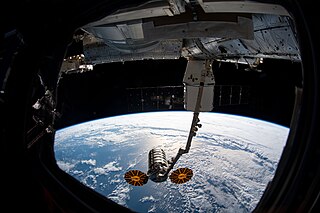
NG-11, previously known as OA-11, is the twelfth flight of the Northrop Grumman robotic resupply spacecraft Cygnus and its eleventh flight to the International Space Station under the Commercial Resupply Services (CRS-1) contract with NASA. The mission launched on 17 April 2019 at 20:46:07 UTC. This is the last mission from the extended CRS-1 contract; follow-up missions are part of the CRS-2 contract. Cygnus NG-11 was also the first mission to load critical hardware onto Cygnus within the last 24 hours prior to launch, a new Antares feature.
On-Orbit Servicing, Assembly, and Manufacturing 2 (OSAM-2), formally known as Archinaut, is a technology project developing the necessary additive manufacturing technology to build large-scale structures in space. The two-year project started in 2016 and was funded by a NASA contract worth US$20 million; it is being performed by a partnership of Made In Space (MIS), Northrop Grumman, and Oceaneering Space Systems. Its formal name is "Versatile In-Space Robotic Precision Manufacturing and Assembly System".
Intelsat 10-02 is a communications satellite operated by Intelsat. Intelsat 10-02 is the first operational communications satellite to have its service life extended by Mission Extension Vehicle-2, while still in service, in 2021.
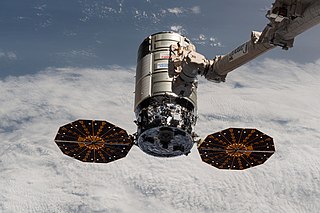
NG-14, previously known as OA-14, was the fifteenth flight of the Northrop Grumman robotic resupply spacecraft Cygnus and its fourteenth flight to the International Space Station under the Commercial Resupply Services (CRS-1) contract with NASA. The mission was launched on 3 October 2020, at 01:16:14 UTC.
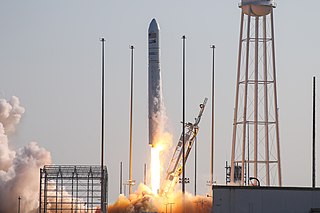
Cygnus NG-16, previously known as Cygnus OA-16, was the sixteenth flight of the Northrop Grumman robotic resupply spacecraft Cygnus and its fifteenth flight to the International Space Station (ISS) under the Commercial Resupply Services (CRS-2) contract with NASA. The mission was launched on 10 August 2021 at 22:01:05 UTC, for a (planned) 90-day mission at the ISS. This was the fifth launch of Cygnus under the CRS-2 contract.
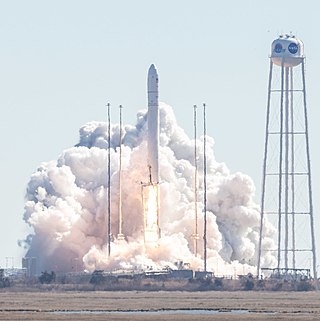
Cygnus NG-17, previously known as Cygnus OA-17, was the seventeenth flight of the Northrop Grumman robotic resupply spacecraft Cygnus and its sixteenth flight to the International Space Station (ISS) under the Commercial Resupply Services (CRS) contract with NASA. The mission launched on 19 February 2022 at 17:40:03 UTC. It was the sixth launch of Cygnus under the CRS-2 contract.

NG-18 was the eighteenth flight of the Northrop Grumman robotic resupply spacecraft Cygnus and its seventeenth flight to the International Space Station (ISS) under the Commercial Resupply Services (CRS-2) contract with NASA. The mission successfully launched on 7 November 2022 at 10:32:42 UTC. This was the seventh launch of Cygnus under the CRS-2 contract.
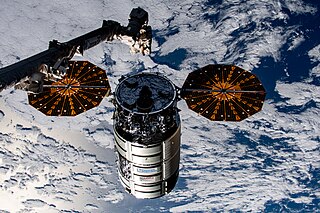
NG-19 was the nineteenth flight of the Northrop Grumman robotic resupply spacecraft Cygnus and its eighteenth flight to the International Space Station (ISS) under the Commercial Resupply Services (CRS-2) contract with NASA. The mission launched on 2 August 2023 at 00:31:14 UTC. This was the eighth launch of Cygnus under the CRS-2 contract.
OSAM-1 was a cancelled NASA spacecraft designed to test on-orbit refilling of satellites. It was previously known as Restore-L.

DARPA’s Robotic Servicing of Geosynchronous Satellites (RSGS) program leverages commercial space technology to inspect and repair aging or broken satellites in the geosynchronous Earth orbit (GEO), about 35,786 kilometers from Earth.